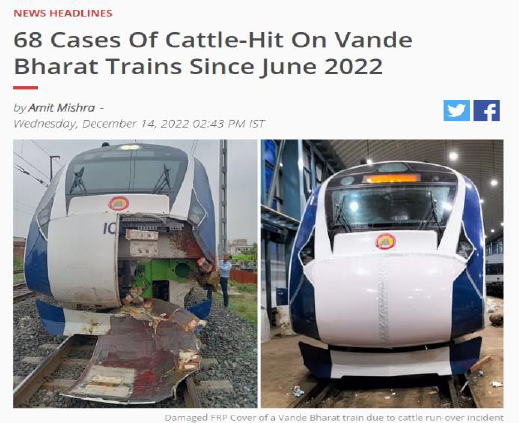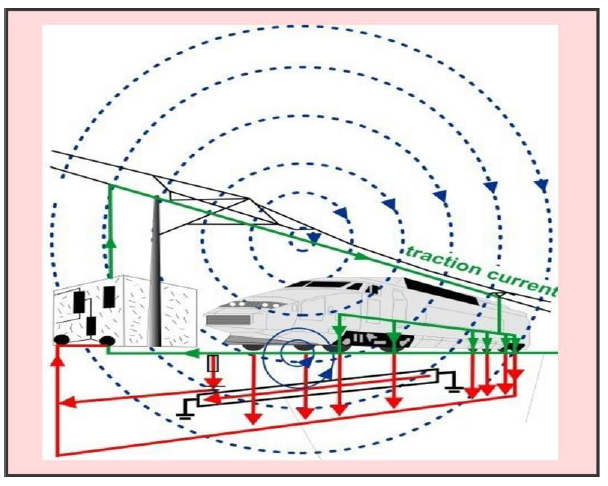Research News
- Exploring the Impact of Welding Processes on Duplex Stainless Steel Parts in Additive Manufacturing August 5, 2024
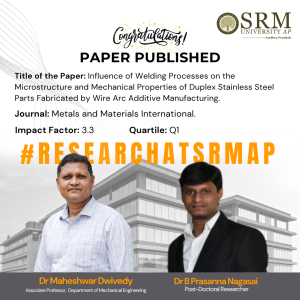 In a recent publication in the prestigious Journal Metals and Materials International, Dr Maheshwar Dwivedy, Associate Professor in the Department of Mechanical Engineering and Dr B Prasanna Nagasai, Post-Doctoral Researcher, delve into the intricate relationship between welding processes and the resulting microstructure and mechanical properties of Duplex Stainless-Steel parts fabricated through Wire Arc Additive Manufacturing.
In a recent publication in the prestigious Journal Metals and Materials International, Dr Maheshwar Dwivedy, Associate Professor in the Department of Mechanical Engineering and Dr B Prasanna Nagasai, Post-Doctoral Researcher, delve into the intricate relationship between welding processes and the resulting microstructure and mechanical properties of Duplex Stainless-Steel parts fabricated through Wire Arc Additive Manufacturing.The research paper, aptly titled “Influence of Welding Processes on the Microstructure and Mechanical Properties of Duplex Stainless-Steel Parts Fabricated by Wire Arc Additive Manufacturing,” illuminates the crucial factors that influence the quality and performance of components produced using this innovative manufacturing technique.
This collaborative effort not only enriches the academic community but also holds promising implications for the advancement of additive manufacturing technologies, particularly in the realm of Duplex Stainless-Steel fabrication. By unravelling the impact of different welding processes on the microstructural characteristics and mechanical behaviour of such components, the researchers offer valuable insights that can potentially enhance the efficiency and reliability of the manufacturing process.
The publication of this paper signifies a significant milestone in the ongoing exploration of material science and additive manufacturing techniques, highlighting the dedication and expertise of Dr Maheshwar Dwivedy and Dr B Prasanna Nagasai in pushing the boundaries of knowledge and innovation in the field.Abstract
Direct energy deposition (DED) is an advanced additive manufacturing (AM) technique for producing large metal components in structural engineering. Its cost-effectiveness and high deposition rates make it suitable for creating substantial and complex parts. However, the mechanical and microstructural properties of these components can be influenced by the varying heat input and repeated thermal treatments associated with different welding procedures used during the deposition process. This study employed gas metal arc welding (GMAW) and cold metal transfer (CMT) arc welding techniques to fabricate cylindrical components from 2209 duplex stainless steel (DSS).
The research investigated the impact of these welding methods on the microstructure and mechanical properties of the 2209 DSS cylinders. The intricate thermal cycles and cooling rates inherent in the DED process significantly influenced the primary phase balance, ideally comprising 50% austenite and 50% ferrite. In components processed using GMAW, σ-phase formation was noted at the grain boundaries. Additionally, a slower cooling rate and extended time for solid-state phase transformations led to an increase in austenite content from the bottom to the top of the component. The cylinder fabricated using the CMT process exhibited fine austenite morphologies and a higher ferrite content compared to the GMW-processed cylinder.
Furthermore, the cylinder produced using the CMT process showed consistent properties across the building direction, unlike the components manufactured with the GMW process. In terms of tensile properties, hardness, and impact toughness, the cylinder produced using the CMT technique outperformed the one made with the GMW process.
Research in Layperson’s Terms
Over the last ten years, a new way of making things called additive manufacturing (AM) has become really popular, especially in industries like aerospace, oil, and gas. This technology builds parts layer by layer, which is a big change from traditional methods that often involve cutting away material to shape a part. One specific method of AM, called Directed Energy Deposition (DED), is particularly good at creating complex metal parts quickly and efficiently. A special kind of stainless steel called duplex stainless steel (DSS) is made of two types of microstructures, ferrite and austenite, which give it great strength and resistance to corrosion. This makes it ideal for use in demanding environments like the oil and gas industry.
A technique within DED called Wire Arc Additive Manufacturing (WAAM) is becoming a popular way to make large, strong metal parts like pipes and storage tanks. WAAM uses the same equipment as welding and can build parts by melting wire with an electric arc. It’s faster and cheaper than other AM methods. However, the process can change the structure of the metal, which affects its properties. For example, too much heat can reduce the amount of ferrite in the metal, making it less strong.
Researchers have been studying how different methods of WAAM, including ones that use less heat, affect the metal’s structure and properties. They’ve found that controlling the heat can lead to better mechanical properties, like higher strength and toughness. They’ve also looked at new technologies like digital twins (virtual models of the manufacturing process) to improve the stability and consistency of the process. In this study, researchers focused on making cylindrical parts from 2209 DSS using two different welding processes within WAAM: Gas Metal Arc Welding (GMAW) and Cold Metal Transfer (CMT).
They studied how these processes affected the metal’s structure and properties, like tensile strength, hardness, and toughness. The goal was to understand which process produces the best quality parts for industrial use. In summary, the research aims to improve the manufacturing of strong, corrosion-resistant metal parts using advanced AM techniques, making them more efficient and cost-effective for industries that need durable components.
Practical Implementation or the Social Implications Associated
The practical implementation of this research can revolutionise industrial manufacturing, especially in sectors like aerospace, oil and gas, automotive, and marine applications. Using WAAM with DSS, industries can produce lightweight, high-strength parts that withstand extreme environments, significantly improving efficiency and cost-effectiveness. WAAM’s ability to quickly produce customized and high-quality components also makes it ideal for rapid prototyping and repair, reducing lead times and overall production costs. Furthermore, WAAM is a more sustainable manufacturing method, generating less waste and utilizing recycled materials, contributing to eco-friendly production practices. The social implications are substantial, including the creation of new job opportunities and the need for specialized training programs to equip workers with advanced skills.
The economic impact is also notable, as WAAM enhances the competitiveness of companies, driving economic growth in high-tech industries. Innovation is fostered through advancements in manufacturing processes and materials science, leading to improved product performance and longevity, particularly in safety-critical applications. Additionally, the environmental benefits of reduced waste and potential use of recycled materials align with global sustainability goals. Overall, the adoption of WAAM can democratize the manufacturing landscape, making advanced technologies more accessible and affordable for smaller companies and startups, thereby fostering a more inclusive and innovative industrial environment.
Future Research Plans:
Continue reading →
The upcoming work will focus on creating Functionally Graded Materials (FGMs) using Wire Arc Additive Manufacturing (WAAM) by merging various metals, including nickel, stainless steel, mild steel, Inconel 718, and AISI 410 MSS. The goal is to optimise material interfaces, refine deposition processes, and ensure structural integrity for high-performance applications. - Unraveling Chaos Dynamics in Cancer: Dr Koyel Chakravarty’s Breakthrough Research August 5, 2024
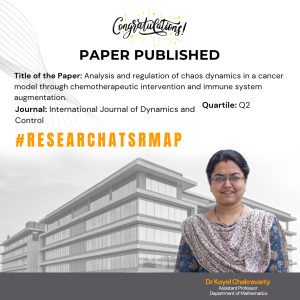 Dr Koyel Chakravarty, Assistant Professor in the Department of Mathematics, has made a significant contribution to the field of cancer research with her paper “Analysis and Regulation of Chaos Dynamics in a Cancer Model through Chemotherapeutic Intervention and Immune System Augmentation,” which was recently published in the International Journal of Dynamics and Control. In her paper, Dr Chakravarty delves into the intricate world of chaos dynamics within a cancer model and explores the potential for regulating these dynamics through the combined approach of chemotherapeutic intervention and immune system augmentation.
Dr Koyel Chakravarty, Assistant Professor in the Department of Mathematics, has made a significant contribution to the field of cancer research with her paper “Analysis and Regulation of Chaos Dynamics in a Cancer Model through Chemotherapeutic Intervention and Immune System Augmentation,” which was recently published in the International Journal of Dynamics and Control. In her paper, Dr Chakravarty delves into the intricate world of chaos dynamics within a cancer model and explores the potential for regulating these dynamics through the combined approach of chemotherapeutic intervention and immune system augmentation.Her research offers insights into understanding the complex behaviour of cancer cells and how such insights can be leveraged to develop more effective treatment strategies. Dr Chakravarty’s work marks a crucial step forward in the ongoing efforts to combat cancer, shedding light on the dynamic interplay between therapeutic interventions and the body’s immune response.
The publication of this paper not only underscores Dr Koyel’s expertise in the field of mathematical analysis in cancer research but also signifies a promising advancement in the collective pursuit of understanding and addressing the challenges posed by cancer.
Abstract
The focus of the current investigation lies in the formulation and analysis of a dynamic model depicting cancer growth, incorporating the joint influences of chemotherapy and immune system augmentation. The primary emphasis of this study revolves around the analysis of the dynamic behaviour within a living-cell closed carcinoma system, specifically one devoid of external vitamin support, with a particular exploration of chaos dynamics. Subsequently, the authors aim to scrutinise the pivotal impact of infused vitamins in attaining stable system dynamics through the application of chaos control techniques.
The formulated model exhibits fundamental mathematical properties, revealing a spectrum of co-dimension one and co-dimension two bifurcations. The identification of specific bifurcation types relies on algebraic criteria techniques, where conditions necessary and sufficient for bifurcation types are developed. Notably, these criteria are distinct from traditional approaches based on the characteristics of the eigenvalues of the Jacobian matrix, instead relying on coefficients derived from characteristic equations. The accuracy of the analytical conclusions is validated through numerical findings, elucidating diverse bifurcation structures. The article enriches its contribution by delving into the control of chaos through the reinforcement of the internal immune system and the maintenance of the biological system’s stability. This work culminates in proposing future directions aimed at advancing a more realistic approach to eradicating cancer.
Research in Layperson’s Terms
This study focuses on developing and analysing a model that simulates how cancer grows, considering both chemotherapy and the immune system’s response. The main goal is to understand how cancer behaves over time in a system that doesn’t have external vitamin support, especially looking at how chaotic or unpredictable the growth can become. The researchers also investigate how adding vitamins might help stabilise this chaotic system using specific control techniques. The model they created has certain mathematical features that show different types of changes, called bifurcations, which can occur under specific conditions.
Additionally, the study explores how strengthening the immune system might help control this chaos and stabilise the biological system. The paper concludes by suggesting future research directions that could lead to more effective cancer treatment strategies.Practical implementation
The practical implementation and social implications of analysing and regulating chaos dynamics in a cancer model through chemotherapeutic intervention and immune system augmentation can be profound. Insights gained from this research could be applied to optimize cancer treatment protocols, potentially leading to more effective therapies with reduced side effects. By understanding and controlling the chaotic behaviour in cancer systems, patient outcomes could be improved through personalized treatment strategies.
Socially, the adoption of these findings may lead to increased public confidence in advanced cancer treatments, as well as a broader acceptance of integrating immune system support with traditional therapies. The potential for more stable and predictable treatment outcomes may also reduce the emotional and financial burden on patients and healthcare systems. Additionally, this approach may encourage further interdisciplinary research, bridging gaps between Mathematics, Biology, and Medicine, thus fostering innovation in cancer therapy development.Collaborations
Dr Lakshmi Narayan Guin, Associate Professor, Department of Mathematics, Siksha Bhavana, Visva-BharatiFuture research plans
Potential areas for further exploration include:- Personalised Medicine: Developing patient-specific models that consider individual biological variations could lead to more tailored and effective cancer treatments, minimising side effects and improving outcomes.
- Integration with Advanced Therapies: Combining the insights from chaos dynamics with emerging therapies such as immunotherapy, targeted therapy, and gene editing could enhance the precision and efficacy of cancer treatments.
- A Look into Sequential Art: Exploring Sean Michael Wilson’s Graphic Creations August 5, 2024
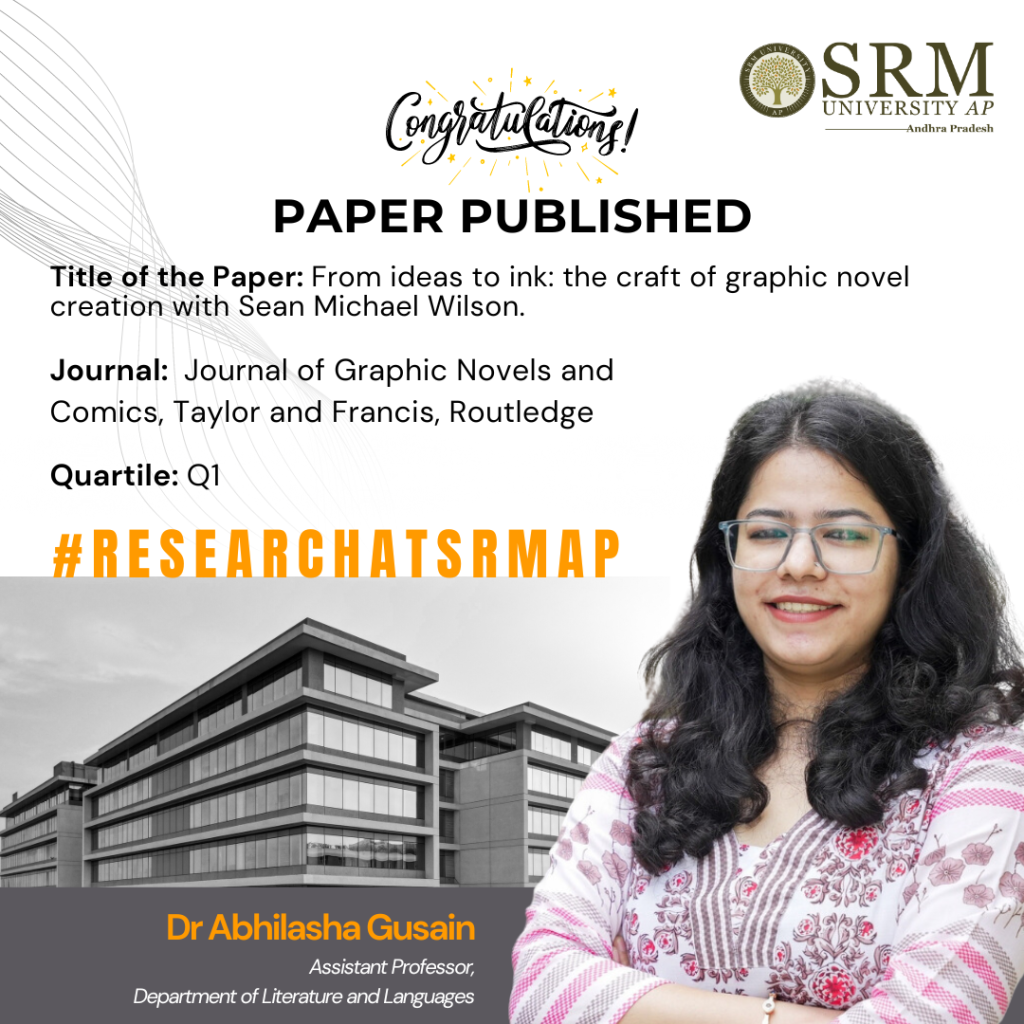
Graphic novels, a subgenre of comics, have witnessed stellar growth in popularity, encouraging readers to decipher meaning from the text and the images. The combination of visual and textual storytelling aids readers in decoding complex narratives. Dr Abhilasha Gusain, Assistant Professor from the Department of Literature and Languages, has published a paper titled “From Ideas to Ink: The Craft of Graphic Novel Creation with Sean Michael Wilson” in the Journal of Graphic Novels and Comics.
The current research advances the field of comics studies, highlighting aspects related to the industry like readership, publication, and distribution of graphic narratives across the globe. It emphasises the process of creation of a graphic novel, with reference to author Sean Michael Wilson’s works.
Abstract
In this interview, Sean Michael Wilson delves into his multifaceted career as a graphic novel writer, revealing the intricacies of his creative process, the challenges of adapting complex subjects into visual narratives, and the evolving role of graphic novels in cultural discourse. With over 40 projects under his belt, Wilson shares his approach to beginning new works, whether they stem from original ideas or/are adaptations of historical events and existing literature. He discusses the balance between authenticity and readability, the importance of research, and the collaborative dynamic between writer and artist in bringing graphic novels to life. Wilson also touches on the broader implications of graphic novels in education and social commentary, the economic realities of the industry, and the impact of digital platforms on publishing. His experiences across different cultures, particularly between the West and Japan, provide insight into the global reception of his work. Throughout the interview, Wilson emphasises the power of graphic novels as a medium for storytelling, education, and political engagement.
Continue reading → - Dr Sunil Publishes Paper on Ethereum Blockchain Framework in IEEE Access August 2, 2024
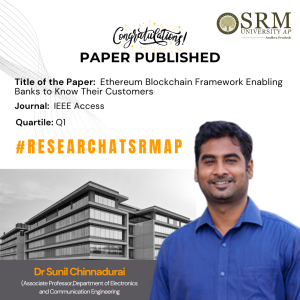 We are thrilled to announce that Dr Sunil Chinnadurai, Associate Professor in the Department of Electronics and Communication Engineering has published a significant research paper titled “Ethereum Blockchain Framework Enabling Banks to Know Their Customers” in the esteemed journal IEEE Access. In his paper, Dr Chinnadurai explores the innovative applications of Ethereum blockchain technology in enhancing customer verification processes within the banking sector. His research addresses the growing need for robust and secure methods for banks to comply with Know Your Customer (KYC) regulations while ensuring customer privacy and data integrity.
We are thrilled to announce that Dr Sunil Chinnadurai, Associate Professor in the Department of Electronics and Communication Engineering has published a significant research paper titled “Ethereum Blockchain Framework Enabling Banks to Know Their Customers” in the esteemed journal IEEE Access. In his paper, Dr Chinnadurai explores the innovative applications of Ethereum blockchain technology in enhancing customer verification processes within the banking sector. His research addresses the growing need for robust and secure methods for banks to comply with Know Your Customer (KYC) regulations while ensuring customer privacy and data integrity.
This pioneering work contributes to the ongoing discourse on digital transformation in the banking industry and presents a framework that could potentially revolutionise customer onboarding and identity verification practices.
We extend our congratulations to Dr Chinnadurai for this remarkable achievement and look forward to his continued contributions to the field of electrical and electronics engineering. His research not only enhances the academic reputation of SRM University-AP but also paves the way for innovative solutions in the financial sector.Abstract of the Research
This paper looks at how blockchain technology can improve the Know Your Customer (KYC) process. It aims to make things more open, secure, and unchangeable. Banks can use the Ethereum blockchain to get and keep customer information, which saves time and money. The solution tries to solve problems with KYC procedures making sure banks follow the rules and stop fraud. The central bank will keep a list of all banks and check if they’re doing KYC right. This spread-out approach gives banks a good long-lasting way to bring in new customers.Explanation of the Research in Layperson’s Terms
Our study seeks to cause a revolution in the Know Your Customer (KYC) process for banks using Ethereum blockchain technology. Current KYC methods take too long, cost too much, and leave room for cheating. Blockchain offers a clear, safe, and unchangeable platform to store customer data letting banks check and confirm identities. This spread-out approach means customers only need to complete the KYC process one time, which saves a lot of time and money for both banks and customers. Also, blockchain’s safety features make sure that private data stays unchanged and safe from people who shouldn’t see it. Our planned system involves the central bank keeping a full list of all banks and watching to make sure they follow KYC rules. In the future, we plan to put our solution on the real Ethereum network and build a working decentralized app. This system promises to make KYC processes faster, safer, and cheaper, giving a strong answer for banks all over the world.Practical Implementation or the Social Implications associated
Our research puts blockchain tech to work to improve how banks verify customers. This decentralized system gives everyone access to the same current info through a shared record. This cuts down on middlemen and their costs. Smart contracts that run on their own speed up checks with less human involvement. This lowers the chance of data getting out. It makes transactions faster and keeps data safe from changes it shouldn’t have. This new way of checking customers can save money, make customers happier, and follow rules better. It can make people trust banks more by keeping data safer and being more open. It also means banks don’t have to do the same checks over and over, which is better for them and their customers. In the end, our blockchain answer for customer checks aims to make banking safer, smoother, and cheaper. It should also help build more trust in banks overall.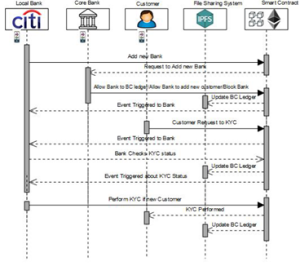
FIGURE 1. Implementation of a blockchain-based KYC process
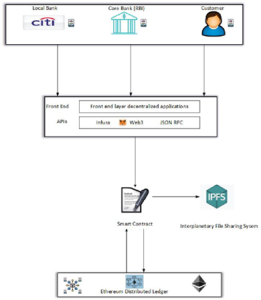
FIGURE 2. Sequential flow diagram illustrating the proposed KYC process using blockchain technology
Future Research Plans
We’re planning to test our idea a lot on the Ethereum network to make sure it works well. We want to build a working DApp that shows our KYC system is doable. We’ll check if people might use it and look at how safe and private it is. By doing this, we hope to make a strong and reliable DApp that’s easy to use, open, safe, and quick. In the end, we want to create something that makes KYC better and sets a new bar for money stuff making banking safer and faster for everyone. Our main goal is to make a system that does not improve how KYC works but also changes how money moves around, making sure banks are safer and work better for people.
Continue reading → - Dr Raviteja K Publishes Book on Sustainable Materials in Civil Infrastructure July 29, 2024
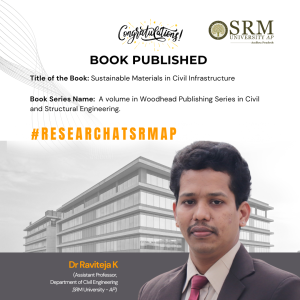 Dr Raviteja K, Assistant Professor in the Department of Civil Engineering, has recently authored a groundbreaking book entitled “Sustainable Materials in Civil Infrastructure.” This publication is set to become a valuable resource for professionals and students in the field, shedding light on the importance of sustainable practices in construction and infrastructure development. His expertise and dedication to promoting environmentally friendly solutions within the realm of civil engineering have culminated in this significant literary contribution. The book delves into the utilization of eco-conscious materials, innovative construction techniques, and the crucial role they play in creating a more sustainable future for infrastructure projects worldwide.
Dr Raviteja K, Assistant Professor in the Department of Civil Engineering, has recently authored a groundbreaking book entitled “Sustainable Materials in Civil Infrastructure.” This publication is set to become a valuable resource for professionals and students in the field, shedding light on the importance of sustainable practices in construction and infrastructure development. His expertise and dedication to promoting environmentally friendly solutions within the realm of civil engineering have culminated in this significant literary contribution. The book delves into the utilization of eco-conscious materials, innovative construction techniques, and the crucial role they play in creating a more sustainable future for infrastructure projects worldwide.His work is anticipated to inspire a new wave of sustainable practices in the industry and drive positive change towards greener and more resilient civil infrastructure development. Congratulations to Dr. Raviteja K on this remarkable achievement that is sure to make a lasting impact in the field of civil engineering!
Publication details (incl. Publisher, ISBN, Launch date, Edition, etc):
Title: Sustainable Materials in Civil Infrastructure, Publisher: Elseveir, ISBN: 978-0-443-16142-1, Date: July 2024, doi: https://doi.org/10.1016/C2022-0-02477-6.Brief Introduction the Book:
Sustainable Materials in Civil Infrastructure delves into cutting-edge advancements in eco-materials, offering solutions crucial for building resilient and sustainable infrastructure. It provides profound insights into pioneering research on eco-materials for construction, offering a comprehensive guide on recycled steel, low-carbon concrete, bioconcrete, self-healing concrete, and industrial by-products like fly ash and shape memory alloys. Chapters explore design applications of bioconcrete and the utilisation of eco-materials in landfill liners and masonry, while also addressing obstacles hindering the widespread adoption of green concrete and bioconcrete, proposing practical solutions. This book serves as a cornerstone for the development of sustainable design methodologies, embraced by environmental monitoring bodies worldwide.Significance of Book
The book “Sustainable Materials in Civil Infrastructure” published by Elsevier is a pivotal resource in the field of sustainable engineering, particularly relevant to my work in developing solutions for geotechnical and geoenvironmental challenges at Sustainable Engineering Research Laboratory (SERL), SRM University AP.The inclusion of topics such as bioconcrete and the utilization of eco-materials in landfill liners and masonry is particularly significant. Bioconcrete, for instance, exemplifies a pioneering approach by integrating biological processes into construction materials, thereby promoting sustainability and durability. Addressing obstacles to the widespread adoption of green concrete and bioconcrete is also crucial, as it underscores the practical challenges that need to be overcome for these materials to achieve mainstream acceptance.
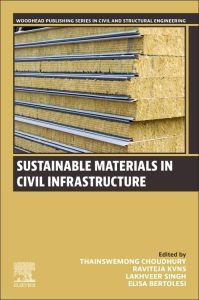
For my research focus at SERL, this book serves as a cornerstone. It not only provides in-depth insights into the latest research and development in sustainable materials but also offers practical guidance on their design applications and integration into infrastructure projects. Moreover, the emphasis on sustainable design methodologies aligns perfectly with our laboratory’s mission to promote environmentally conscious practices in civil engineering.
Target Audience of the Book
The target audience of the book “Sustainable Materials in Civil Infrastructure” includes a wide range of professionals and researchers involved in civil engineering, sustainability, and materials science. Specifically, the book would be helpful and resourceful for:
Civil Engineers, Researchers and Academics, Environmental Engineers, Policy Makers and Regulatory Bodies, Students, Construction Industry Professionals, and Consultants.Co-authors
The co-editors include: Thainswemong Choudhury, Lakhveer Singh and Elisa BertolesiThe Link of the Book Publication
Continue reading → - Innovation Alert: Patent on Plant Disease Detection Published by CSE Team July 29, 2024
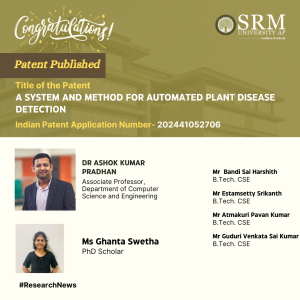 In an impressive achievement, Dr Ashok Kumar Pradhan, Associate Professor of the Department of Computer Science and Engineering, along with PhD Scholar Ms Ghanta Swetha and BTech CSE students Mr Bandi Sai Harshith, Mr Estamsetty Srikanth, Mr Guduri Venkata Sai Kumar, and Mr Atmakuri Pavan Kumar, has successfully published a patent titled “A SYSTEM AND METHOD FOR AUTOMATED PLANT DISEASE DETECTION.” The application has been officially recognised with Application Number: 202441052706, as recorded in the Patent Office Journal.
In an impressive achievement, Dr Ashok Kumar Pradhan, Associate Professor of the Department of Computer Science and Engineering, along with PhD Scholar Ms Ghanta Swetha and BTech CSE students Mr Bandi Sai Harshith, Mr Estamsetty Srikanth, Mr Guduri Venkata Sai Kumar, and Mr Atmakuri Pavan Kumar, has successfully published a patent titled “A SYSTEM AND METHOD FOR AUTOMATED PLANT DISEASE DETECTION.” The application has been officially recognised with Application Number: 202441052706, as recorded in the Patent Office Journal.This innovative system aims to revolutionise the agricultural sector by providing an automated mechanism for detecting diseases in plants. Thus, it enhances crop management and ensures healthier yields. The team’s dedication to advancing technology and improving agricultural practices showcases the potential of computer science in solving real-world problems.
The patent not only reflects the hard work and collaboration among the faculty and students but also signifies a step forward in the integration of technology with agriculture. As the world faces challenges related to food security, such innovations play a critical role in safeguarding plant health and agricultural productivity.
Congratulations to Dr Pradhan, Ms Swetha, and the student inventors on this significant milestone in their academic and professional endeavours!
Abstract of the Research:
The innovation that is being presented in this project is a software-based system that is intended to help farmers by offering an automated way to identify plant diseases. This innovation combines a number of technological elements:Convolutional Neural Networks (CNNs): These networks are used to recognise and categorise plant diseases from images of both healthy and sick plants with high accuracy. This is leveraging transfer learning with pre-trained CNN architectures to improve performance even with sparsely annotated data.
MobileNetV2 Architecture: Designed with the specific purpose of classifying agricultural diseases in mind, this model is effective and lightweight, making it ideal for use in resource- constrained settings such as farms.
Weather API Integration: This helps farmers make decisions about crop management and disease prevention by giving them access to real-time weather data.
AI-Powered Website: Acts as a user interface for farmers to communicate with the system, submit plant photos, post queries, and get weather and diagnostic updates.
Chatbot: Utilizes Recurrent Neural Networks (RNN) and Natural Language Processing (NLP) to respond to user inquiries and provide guidance on crop management and disease prevention.
All things considered, this innovation is a system that integrates various software components, artificial intelligence, and data integration to produce a complete tool for raising agricultural productivity and managing diseases.
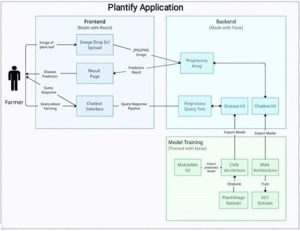
Research in Layperson’s Terms
1. Automated Plant Disease Prediction: Current approaches frequently use traditional diagnostic procedures and manual inspection, which can be laborious and prone to human mistakes. The suggested method uses CNNs to automatically and precisely recognise images, increasing the efficacy and precision of plant disease diagnosis.
2. This project assists farmers in making decisions on crop management and disease prevention by providing them with access to current weather information.
3. Farmers can query various farming issues and receive responses. This is done by leveraging RNNs and NLP.
4. Use of Transfer Learning: The system uses transfer learning to use pre-trained CNN architectures, which enables it to function well even with a small amount of annotated data. Compared to typical machine learning models, which frequently need big datasets and intensive training, this is a major improvement.
Integration with Smart Agriculture Systems: – This method combines disease prediction with smart agriculture systems, allowing for real-time monitoring and decision-making, in contrast to independent diagnostic instruments.Practical Implementation or the Social Implications Associated
1. Field Diagnosis by Farmers: – Farmers can snap photos of their crops in the fields and instantly receive a disease diagnosis and treatment suggestions by using the platform.2. Agricultural Extension Services: Using the system, agricultural extension agents may help farmers more effectively by offering guidance and support.
3. Agricultural Research: – Researchers can investigate plant diseases and create novel remedies and management techniques by utilizing the extensive annotated picture library and diagnostic tools.
4. Commercial Farming Operations: – By incorporating the system into their precision agriculture techniques, large-scale farming operations can maximize crop health management and operational effectiveness.
5. Policy Formation and Governance: – Governmental organizations can monitor plant disease outbreaks and create regional or national plans for disease control and prevention using aggregated data from the platform.
Future research plans
We may use privacy and security enhancement tools and techniques to make the data more secure
Continue reading → - Dr Dwivedy and Dr Nagasai Upgrade CMT Technology July 25, 2024
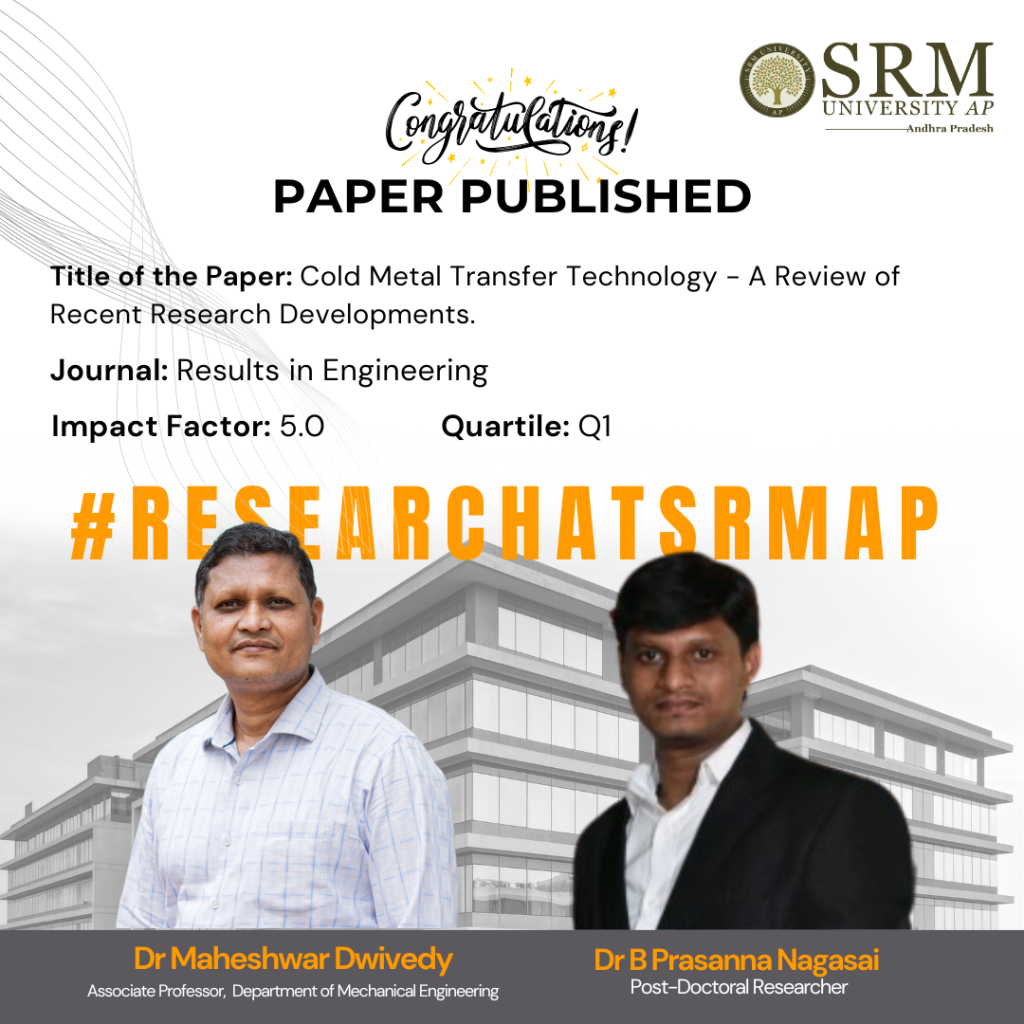
Dr Maheshwar Dwivedy, Associate Dean of Practice School, and Associate Professor, at the Department of Mechanical Engineering, SRM University-AP in collaboration with his post-doctoral scholar, Dr B Prasanna Nagasai, have joined forces to combine artificial intelligence with Cold Metal Transfer (CMT) Technology. Their research paper, “Cold Metal Transfer Technology – A Review of Recent Research Developments,” featured in the Q1 journal, Results in Engineering promises to make a significant impact on automobile, aerospace, oil and gas manufacturing industries, and that’s not all the research will also generate employment opportunities, and empower engineers to deliver enhanced services.
Abstract:
Cold Metal Transfer (CMT) technology has emerged as a promising welding technique, offering numerous advantages such as reduced heat input, minimal spatter, and enhanced control over the welding process. This paper provides a comprehensive review of recent research developments in CMT technology, focusing on its history, variants, recent advancements, and future perspectives. Initially, the paper traces the historical development of CMT welding, highlighting its evolution and the introduction of various CMT variants with distinct characteristics and applications. Recent studies have focused on optimising CMT process parameters to improve weld quality and productivity, leading to advancements in parameter control, arc stability, and wire-feeding mechanisms. Additionally, research has explored the microstructural evolution and mechanical properties of CMT-welded joints for both similar and dissimilar metals, providing insights into material compatibility, joint design, and performance under various conditions. Specific applications such as Laser-CMT hybrid welding, CMT cladding, CMT wire arc additive manufacturing, and CMT welding for repair across various materials are examined, demonstrating the versatility of CMT technology. This review also addresses the challenges and methodologies for defect reduction in CMT welding, along with recommendations for best practices. Furthermore, the paper discusses the integration of artificial intelligence in CMT welding, exploring opportunities for enhanced weld quality, economic, and social implications, and future research directions.
Practical and Social Implications:
The practical implementation of this research on Cold Metal Transfer (CMT) technology can significantly impact various industries, such as automotive, aerospace, oil and gas, and manufacturing. By optimising CMT welding parameters and integrating advanced features like arc length control and waveform modulation, industries can achieve higher weld quality, reduce defects, and enhance productivity. This can lead to more reliable and efficient manufacturing processes, resulting in cost savings and improved product performance. Social implications associated with this research include the potential for increased job opportunities and skill development in the welding and manufacturing sectors. As industries adopt advanced CMT technology, there will be a growing demand for skilled workers trained in these techniques. Additionally, improved welding quality and reduced defects can lead to safer and more durable products, enhancing overall public safety and satisfaction. The integration of artificial intelligence in CMT welding also opens up new avenues for innovation and technological advancements, fostering a culture of continuous improvement and progress in the manufacturing industry.
Collaborations:
Dr V Balasubramanian,
Professor & Director,
Centre for Materials Joining & Research (CEMAJOR)
Annamalai University, Annamalai Nagar-608002, Tamilnadu.Dr P Snehalatha,
Associate Professor & Head
Department of Mechanical Engineering,
Sri Padmavathi Mahila Visvavidyalam, Tirupati, Andhra Pradesh-517502, India.Future Research Plans:
The upcoming work will concentrate on creating Functionally Graded Materials (FGMs) through Wire-Arc Additive Manufacturing (WAAM) by merging nickel and stainless steel. The goal of this research is to leverage the distinct properties of each metal to develop components suited for specialised high-performance applications. The primary challenges involve optimizing the interfaces between materials, refining the deposition processes, and ensuring strong structural integrity throughout the manufacturing process.
The link to the article: https://doi.org/10.1016/j.rineng.2024.102423
Continue reading → - Faculty and Students Leads to Patent Publication for Intelligent Shelf Management System July 22, 2024
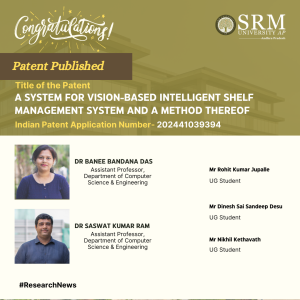 In a groundbreaking collaboration, Dr Banee Bandana Das, Assistant Professor in the Department of Computer Science and Engineering, and Dr Saswat Kumar Ram, Assistant Professor in the Department of Electronics and Communication Engineering, have joined forces with Btech-CSE students Mr Rohit Kumar Jupalle, Mr Dinesh Sai Sandeep Desu, and Mr Nikhil Kethavath to develop and patent an innovative invention.,” The team’s invention, titled “A SYSTEM FOR VISION-BASED INTELLIGENT SHELF MANAGEMENT SYSTEM AND A METHOD THEREOF,” has been officially filed and published with Application Number 202441039394 in the Patent Office Journal. This invention showcases the academic excellence and collaborative spirit within the institution, as faculty members and students work together to push the boundaries of technology and create solutions with real-world impact.
In a groundbreaking collaboration, Dr Banee Bandana Das, Assistant Professor in the Department of Computer Science and Engineering, and Dr Saswat Kumar Ram, Assistant Professor in the Department of Electronics and Communication Engineering, have joined forces with Btech-CSE students Mr Rohit Kumar Jupalle, Mr Dinesh Sai Sandeep Desu, and Mr Nikhil Kethavath to develop and patent an innovative invention.,” The team’s invention, titled “A SYSTEM FOR VISION-BASED INTELLIGENT SHELF MANAGEMENT SYSTEM AND A METHOD THEREOF,” has been officially filed and published with Application Number 202441039394 in the Patent Office Journal. This invention showcases the academic excellence and collaborative spirit within the institution, as faculty members and students work together to push the boundaries of technology and create solutions with real-world impact.
This significant achievement not only highlights the creativity and dedication of the individuals involved but also underscores the institution’s commitment to fostering a culture of innovation and research. The publication of this invention paves the way for further exploration and development in the field of intelligent shelf management systems, demonstrating the potential for transformative contributions to the industry.Abstract
This research offers the best solution to improve the business in the retail realm, maintaining On- Shelf Availability (OSA) is vital for customer satisfaction and profitability. Traditional OSA methods face accuracy challenges, prompting a shift to deep learning models like YOLO and CNN. However, data quality remains a hurdle. This research introduces OSA, a novel semi-supervised approach merging ’semi-supervised learning’ and ’on-shelf availability’ with YOLO. It reduces human effort and computation time, focusing on efficient empty-shelf detection. Implementing a Vision-Based Intelligent Shelf Management System empowers retailers with real-time insights, revolutionizing decision-making. The model is optimized for diverse devices and provides practical solutions for efficient retail operations. Balancing model complexity, size, latency, and accuracy, the research paves the way for an advanced, data-driven shelf management approach, contributing to improved shopping experiences and business profitabilityPractical Implementation and the Social Implications Associated
1. The present invention is a time-saving method in maintaining the stocks.
2. The use Vision-Based Intelligent Shelf-Management System provide a well alternative in reducing the labor efforts.
3. The system will help in terms of self-management system using machine learning techniques to optimize restocking decisions.
The present invention can be used in shopping malls and business areas for enhancing customer experiences and business and few application areas are:
• Smart City and smart Village
This technique and system can reduce the human efforts in identifying vacant slots for items in business areas and provides necessary inputs to fill the same within a time frame.
• Automobile Industry
The system can be easily integrated with the showrooms to identify the empty spaces and inform to get it fill with products.Collaborations
SRM AP Faculties and UROP StudentsFuture research plan
In the future, different deep learning and machine learning methods can be merged to explore better performance in identifying overlapping objects.
Continue reading → - Revolutionising Cattle Safety July 22, 2024
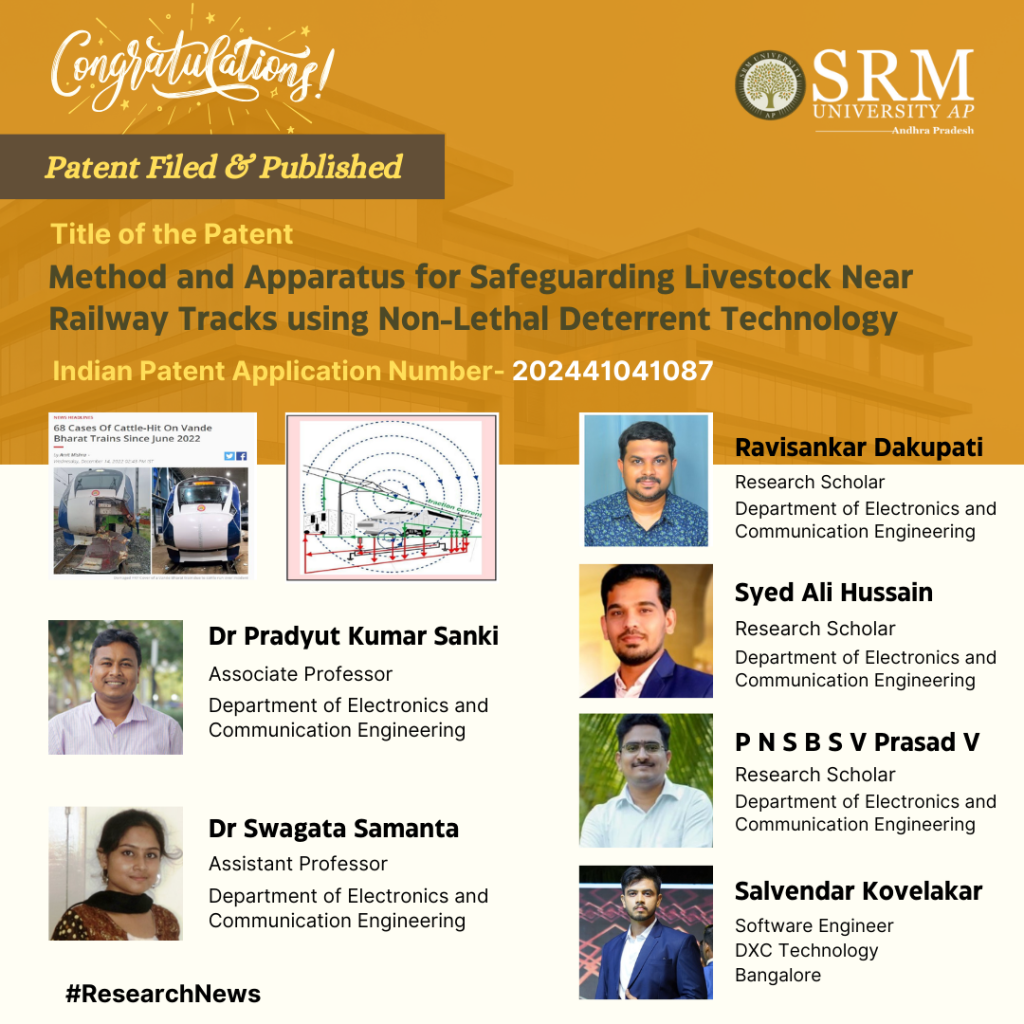
The Department of Electrical and Communication Engineering at SRM University-AP is delighted to announce the publication of a patent by its faculty, including Associate Professor Dr Pradyut Kumar Sanki and Assistant Professor Dr Swagata Samanta, along with research scholars Ravisankar Dakupati, Syed Ali Hussain, and P N S B S V Prasad V. The patent, titled “Method and Apparatus for Safeguarding Livestock Near Railway Tracks using Non-Lethal Deterrent Technology,” has introduced a groundbreaking solution that helps prevent accidents of wandering cattle. This innovative technology promises to protect livestock and minimise economic losses for cattle owners while championing the advancement of technology in countries like India.
Abstract:
Nowadays we have been hearing that Vandebharat express train hits cow, causing damage to both railways and cattle owners. We need to find a solution to this problem. These issues shouldn’t be hurdle for the growth of technology for developing countries like india. The technology we are going to use is a belt is worn by a cow. When the cow tries to cross near railway track it receives a Non-Lethal shock, makes the cow to scare and move back. All this circuit is operated with 7.4V DC
Practical implementation:
The practical implementation of the Anti-Track Cattle Band involves equipping cows with the device to prevent accidents near railway tracks. By detecting magnetic fields and delivering non-lethal shocks, the device ensures the safety of both the cattle and the railway infrastructure. This implementation can significantly reduce the risk of collisions and protect valuable livestock.
From a social perspective, the invention has several implications. It addresses the safety concerns of both animals and humans by preventing accidents and minimizing potential harm. By safeguarding livestock near railway tracks, the technology contributes to animal welfare and reduces economic losses for cattle owners. Additionally, the device promotes a more humane and proactive approach to mitigating risks associated with animal-human interactions in railway environments.Collaborations:
The research on the Anti-Track Cattle Band involved collaboration among a team of inventors with diverse expertise:
Ravisankar Dakupati – Research Scholar at SRM University-AP
Salvendar Kovelakar – Software Engineer at DXC Technology, Bangalore
Syed Ali Hussain – Research Scholar at SRM University-AP
P N S B S V Prasad V – Research Scholar at SRM University-AP
Dr Pradyut Kumar Sanki – Associate Professor at SRM University-AP
Dr Swagata Samanta – Assistant Professor at SRM University-AP
This collaborative effort brought together individuals with backgrounds in research, software engineering, and academia to develop and implement the innovative Anti-Track Cattle Band technology.Future Research Plans:
In future research for patent publication regarding “Apparatus and Method for Railway Livestock Protection,” the focus will likely be on enhancing sensor technology to detect animals more accurately over longer distances and in various conditions. This could involve integrating artificial intelligence and machine learning for improved detection and reducing false alarms. Additionally, there may be efforts to develop systems for remote monitoring and control, enabling real-time adjustments from a central location. Adaptability to different environments, collaboration for standardized protocols, cost-effectiveness, and assessing environmental impacts will also be key areas of interest. Overall, future research aims to create more effective, efficient, and sustainable solutions for protecting livestock around railway tracks
Continue reading → - A Breakthrough Patent for the Automated Abnormality Detection System July 22, 2024
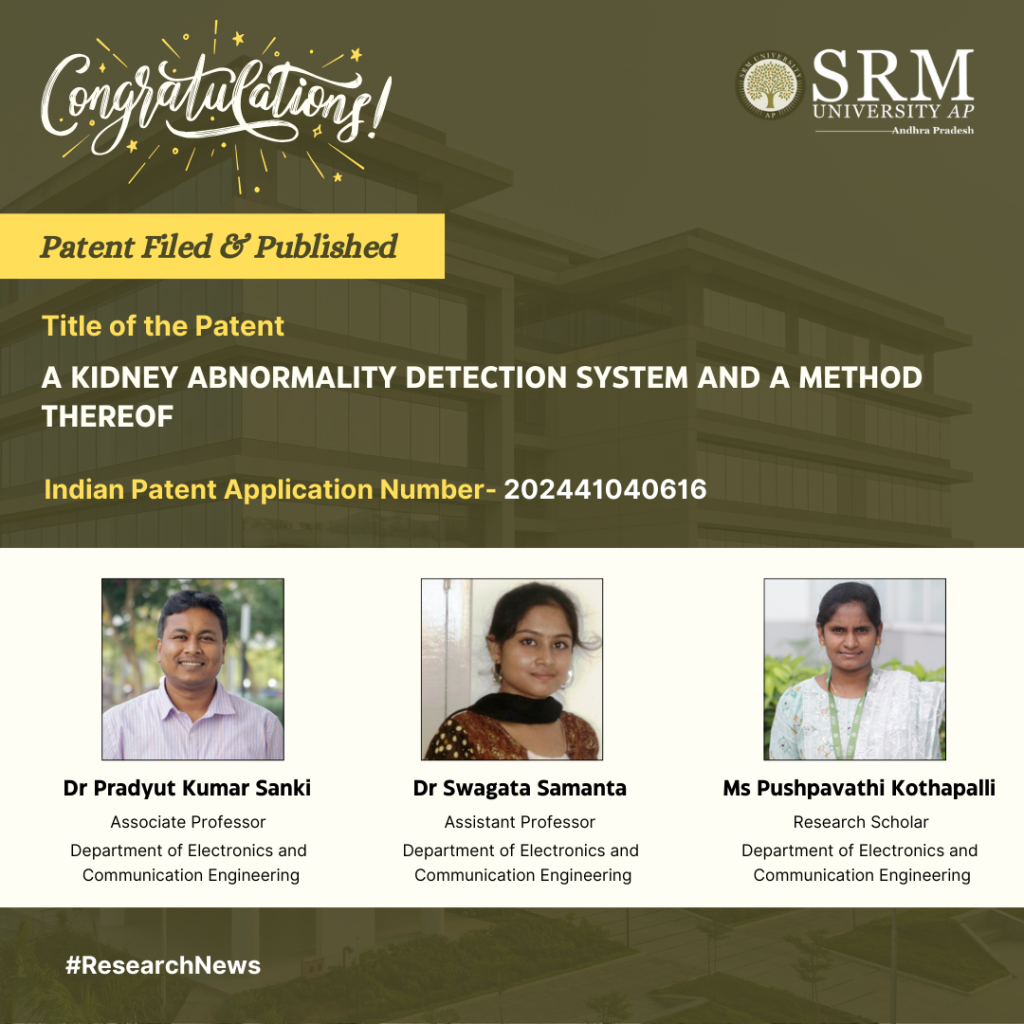
Dr Pradyut Kumar Sanki, Dr Swagata Samanta, and research scholar Ms Pushpavathi Kothapalli from the Department of Electronics and Communication Engineering published their patent titled “A Kidney Abnormality Detection System And a Method Thereof,” with Application No. 202441040616. This innovative method, which utilises advanced deep learning techniques, promises to revolutionise the accuracy and efficiency of kidney disease diagnosis. With the potential for widespread clinical adoption, this technology aims to enhance patient care, offering a brighter future for kidney disease detection and treatment.
Abstract:
This research work aimed to develop a method for detecting kidney diseases, including kidney stones, cysts, and tumors. The method achieved high accuracy in detecting kidney diseases, with a good mean average precision, precision, and recall. The study used techniques to select the most relevant features for kidney disease detection, identifying top features related to blood tests and patient health. The method outperformed other approaches in terms of accuracy, precision, and recall. The study used a comprehensive dataset of kidney disease patients to train and test the method. The results suggest that the method has the potential to be widely adopted in clinical settings, contributing to more accurate and efficient diagnostic tools for kidney disease detection and improving patient care.
Practical implementation:
The practical implementation of our research involves deploying a system for real-time detection and classification of kidney disease, including kidney stones, cysts, and tumors. The method achieved high accuracy in detecting kidney diseases using the Deep learning technique. Our model can quickly identify the disease of the kidney. The study used techniques to select the most relevant features for kidney disease detection, identifying top features related to blood tests and patient health. The method outperformed other approaches in terms of accuracy, precision, and recall. The study used a comprehensive dataset of kidney disease patients to train and test the method. The results suggest that the method has the potential to be widely adopted in clinical settings, contributing to more accurate and efficient diagnostic tools for kidney disease detection and improving patient care.
Future Research Plans:
The future plans for the work on chronic kidney disease (CKD) detection and management involve several key areas:1. Improved Screening and Diagnosis: Update the United States Preventive Services Task Force (USPSTF) recommendation for CKD screening to reflect current evidence supporting routine screening for high-risk asymptomatic adults.
2. Enhanced Patient Engagement and Person-Centered Care: Advance education of primary care clinicians about CKD risk factors, testing, detection, and interventions that are graded and proportional to the eGFR and uACR risk stratification or heat map.
3. Advancements in Nephrology: Develop novel therapeutic strategies, such as wearable artificial kidneys, xenotransplantation, stem cell-derived therapies, and bioengineered and bio-artificial kidneys, to improve renal replacement therapies and address the shortage of kidney donors.
4. Machine Learning and Predictive Modelling: Continue to evaluate and improve machine learning approaches for early CKD diagnoses, focusing on reducing the number of input features and enhancing the accuracy of prediction models.
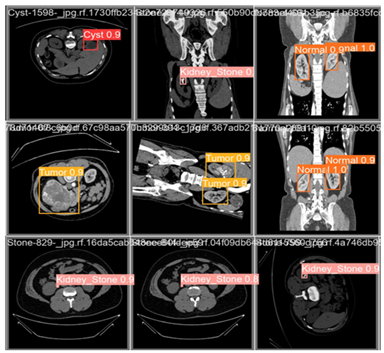
Continue reading →


